Table of Contents
Introduction
We treat patients who have many different foot and ankle problems here at Premier Podiatry & Orthopedics. And with the numerous conditions and injuries that can be sustained in the lower limbs, it makes sense there are also a variety of root causes for these medical issues.
In some cases, the problem is an inherited structural issue, such as flat feet. Others are problems caused by microorganisms such as fungal toenails and athlete’s foot. Still others stem from diseases and disorders, including peripheral neuropathy and rheumatoid arthritis.
These are all conditions that come about gradually, which means you have plenty of time to address problems before the pain really kicks in. But when it comes to physical trauma, you may not have as much time to prepare for it. In fact, you may not be able to prevent it at all!
People tend to be quick to associate trauma with blunt forces, but the truth is trauma can refer to any injury that has a sudden onset and may require immediate medical attention. Often, this is a serious medical concern, with potential problems including blood loss and severe pain.
Let’s dive a little deeper.
Common Foot Injuries Caused by Physical Trauma
Bones are tasked with providing structure for our bodies. With this being the case, it only stands to reason that they don’t have much “give” in them and will break in response to excessive force. Fortunately, the human body has an amazing ability to repair itself when issues arise, including being able to mend a fractured bone.
Blunt force can often, but not always, lead to a broken bone. There are different types of fractures which can be sustained by physical trauma, including:
- The broken bone has not pierced the skin.
- The skin has been punctured by either the broken bone itself or by the physical trauma that caused the break.
- The bone has shattered into three or more pieces.
- The fracture line of the bone is angled.
- The fractured ends of the bone line up in a normal fashion and will heal correctly.
- The fracture line of the bone is horizontal.
When it comes to treating bone fractures, the body does the majority of the heavy lifting, but we are responsible for ensuring that bones are lined up correctly and the area is stabilized.
Some of the tools and forms of treatment we might use include buddy taping, casting, stiff-soled shoes, crutches, medication, and conservative care methods (rest, ice, elevation). In cases of a compound fracture, however, we may need to perform surgery to line up the broken bone pieces so they heal correctly.
It is important to note that treatment for an open fracture should begin with seeking immediate medical care. Do not attempt to push the bone back inside the wound. Instead, call 911, try to control any bleeding, keep the area clean, and wait for trained medical personnel to arrive on the scene.

Healing Common Foot and Ankle Traumas
The body essentially repairs broken bones in three stages:
- This begins when the fracture happens, and is a necessary stage for providing blood to the injured area. Once there, the blood begins to clot in order to provide an initial framework and stability as the body starts to produce new tissue.
- Bone production. In this second stage, clotted blood starts being replaced by cartilage and fibrous tissues, which, in turn, will be replaced with solid bone tissue.
- Bone remodeling. During the final stage, bone tissue develops and becomes dense and compact. At this point, circulation returns to its normal levels.
Various factors play a role in dictating exactly how long the entire healing process will take. In most cases, a broken bone needs about 6 to 8 weeks for a significant degree of healing, with adult bones taking longer to heal then children’s bones.
Preventing Foot and Ankle Fractures
- Wear proper footwear. Shoes should be activity-appropriate, fit correctly, and provide ample cushioning and arch support. If running shoes are worn out – usually after 300-500 miles – they should be replaced.
- Make gradual changes in physical activity. When starting a new workout or exercise program, start at low levels of intensity and duration and slowly build them up over time. This will allow your body to adjust to the greater physical demands you are placing upon it.
- Cross-train. This is a great tip for providing a better overall level of fitness in general, but incorporating low-impact activities like cycling, swimming, and yoga into your workout can also reduce your risk of developing a stress fracture.
- Eat well. Proper nutrition, including a diet rich in calcium and other essential nutrients, will help keep your bones healthy and strong.
Contact Us for Treatment
No matter if your foot or ankle issue is caused by physical trauma or has any other origin, you can find the effective care and treatment you need at Premier Podiatry & Orthopedics. Our skilled, knowledgeable podiatrists are ready to listen to you, determine the root cause of the issue, and then create a plan to relieve painful symptoms and restore functionality.
For more information on trauma and the treatment options we provide, or if you have any questions about our practice, give us a call at (916) 961-3434 today. You can also request an appointment with our office online – simply fill out our contact form and a member of our staff will reach out to you shortly.
Looking to schedule an appointment with a physician?
Schedule an appointment with us by calling (916) 961-3434 or by clicking the button below to begin requesting your appointment today!



